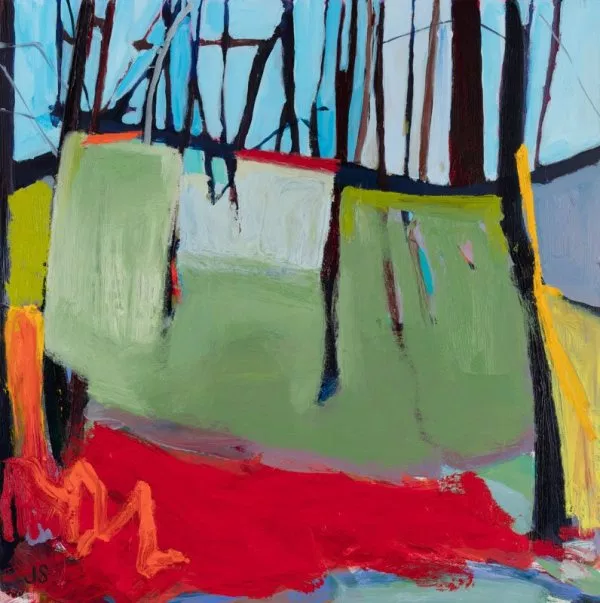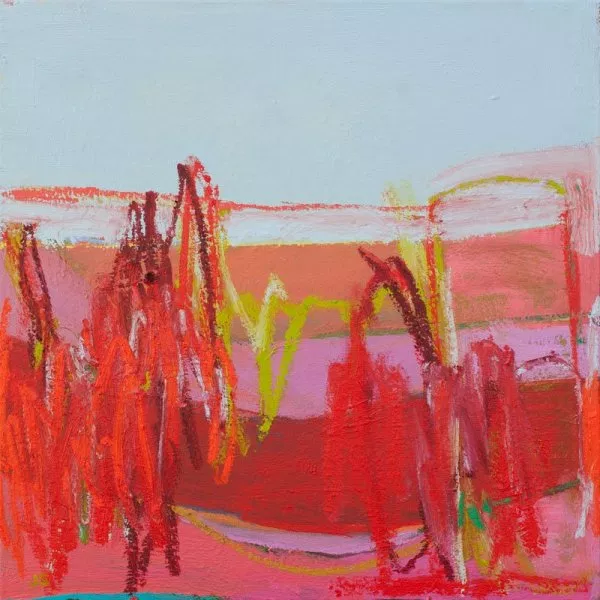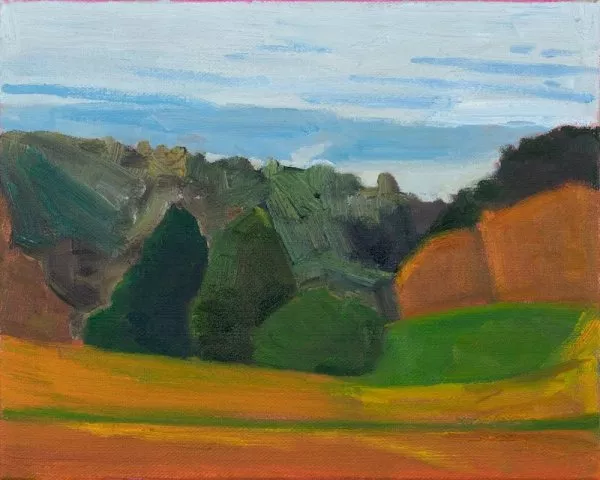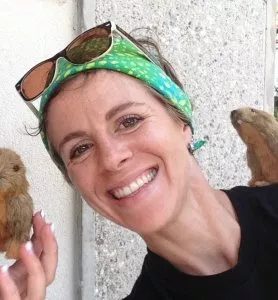Association member Jessica Singerman recently quit her day job to focus on pursuing her art full-time! Woohoo! We sat down to learn more about Jessica’s trajectory: how she arrived from art school to quitting her day job, and what lessons other artists can learn from her experience.
Of her trajectory from art school to quitting her day job to create art full time, Jessica says it was “not linear.”
“I finished my MFA at University of Delaware in 2004 and I had been teaching while I was in school.
I kept teaching, so I was teaching art at University of Delaware and the community college as an adjunct in New Jersey. I was doing the adjunct thing and I was also working at a bike shop.
I was painting, but kind of inconsistently. I didn’t know what I was doing with my life after grad school. I would say the first few years out of graduate school I did not know what I was doing.”

It wasn’t just the sense of uncertainty about the way forward that was an obstacle to Jessica’s success at first. She shares that her understanding about the way that inspiration functions for the working artist was preventing her from making regular work:
“I had this misconception that you will work when you’re inspired. And now I know that that’s really far from the truth. You just work. You put the work in, and then inspiration comes.”
It wasn’t until her son was born and she experienced a crisis of identity that Jessica discovered how to incorporate a daily art practice into her life. She also found that this profoundly alleviated the symptoms of depression and anxiety.

“I set this goal to do a daily project. I would do a project in one sitting, usually when my son was taking a nap, and I started hanging on to this for dear life. I did that for a few months. We were living in Australia at the time, so I didn’t have a studio. My studio was like the contents of a little box. I learned really quickly that I had to make my work space easy to access, and my projects quick to get into with no clean up. I wasn’t using oil paints at the time, I was using watercolors and inks and drawing. Everything was quick to set up and take down.”
Jessica has fallen into a new rhythm since that time. She is still somewhat beholden to her son’s schedule, but most often she chooses to make work first thing in the morning while her “critical brain is off”. It was those early days of motherhood that taught her the importance of making art everyday. Around the time her son was one, she met a fellow artist through a life drawing class who referred her to a gallery in Charlotte. The gallery took her on, which Jessica described as “very validating.” In the end the gallery didn’t work out, however, and Jessica had to flounder a bit before finding new representation that was a better fit. She says of her current situation:
“I’ve got this gallery in Charlotte which is a great fit. The owner trusts me, and she’s willing to take chances on my work, so I’m trying something different. I’m doing a big installation and a video projection in March as well as some paintings, to give her something a little more easy to sell. But I really appreciate that she’s willing to take that chance on me.
I also work with a shop in Winston-Salem. It’s a showroom for really high-end hand built furniture, and they also show other local artists there, so it’s a really nice fit. It’s a beautiful space. I also show at university galleries and other nonprofit spaces as well. This year in September I had a show at Salem College, I have some work going in to a faculty exhibit at a beautiful gallery at Winston-Salem State this month and then I’m showing in an architecture firm also next month.”

This is a surprising amount of activity for Jessica, who was not too long ago struggling to make any work at all and feeling adrift between teaching, a full-time job, and trying to make room for her art. When asked how she accomplished her current lineup of representation and ongoing shows, she shared the details of that “non-linear” path that led her here:
“A friend of mine is friends with the owner of the gallery in Charlotte, and had mentioned my work to her. I showed her my work, and the gallery owner actually approached me, which has never happened in my life, and asked if I wanted to show in a three person show last march. That was kind of like a trial.
The shop in Winston-Salem I found through Instagram. Someone who I didn’t even meet but we were following each other, had mentioned my work to their friends who run this shop. So when they opened the shop they asked me if I wanted to show some work there.
The show at Salem College last year, I found out who the contact was and emailed her. I asked her if I could show there, and actually it wasn’t gonna work out for a couple of years, but then all of a sudden she had a hole she needed to fill. The Winston Salem State show is because I taught at Winston Salem State and they’re doing a faculty exhibit.”

Perhaps one of the key takeaways from Jessica’s experience is that it’s all about who you know. She’s had the benefit of valuable friends and acquaintances both in day-to-day life and on social media who recognized the quality of her work and shared it with others. So the key? Talk about your work.
The flip-side of that coin is that not only does Jessica talk about her work with people she knows and maintain a good online presence, but she also jumps at opportunities that present themselves.

Jessica also has the unique experience of being an art-world native who has had to find her wings outside of the protective bubble of art school and academia. As she has taken steps to grow her own career both with and without gallery representation, he has encountered elitist attitudes about doing the work of selling her own art:
“It’s ego, you know? You don’t want to look like you’re selling your work, because then it’s like you’re selling out. And it’s such a misconception, because the idea is that the galleries are going to take care of it. But even now, I think it’s expected that you still represent yourself on social media. I have friends who are represented by plenty of galleries and they’re still working it on social media.
So for me, it’s ego. It’s been just swallowing a lot of the misconceptions that- I don’t know that they’re actively taught, but you’re definitely made to feel that if you try so hard to sell your own work, you’re selling out or that you’re not a serious artist. Not a lot of people talk about having day jobs in the art world, because it’s like this dirty word. It’s okay to be a teacher, and it’s okay to have a wealthy partner and not mention it. “

Jessica’s current focus is on improving her writing, producing more content for her marketing efforts and finding a new rhythm, having recently quit her day job to pursue art full time (way to go, Jessica!)
“My big thing now really is not to overdo it. My natural tendency is to work all the time. And the big thing I want to work on this year is spending more time with my son. With a day job and teaching, I was teaching last semester, and then my art practice and the business, I was not spending what I felt was enough quality time with him and that’s the big thing for me. That’s the big shift. Spending more time with my son. Not overdoing it. Setting boundaries for myself, and not burning the candle at both ends, which I’m really good at.”
 Growing up, Jessica spent a lot of time drawing and making things. Looking back, the experience of making things was and still is the same for her: she is focused; nothing else matters except for what she is making at that moment, and in the best case scenario, she is in a state of flow. This feeling of being in the moment and fully engaged with her environment and what she is doing is similar to her experience when she is enjoying the outdoors. Whether in a forest or on a mountain top, what resonates with her are the feelings of being connected to the world and at the same time, of being small in a vast universe.
Growing up, Jessica spent a lot of time drawing and making things. Looking back, the experience of making things was and still is the same for her: she is focused; nothing else matters except for what she is making at that moment, and in the best case scenario, she is in a state of flow. This feeling of being in the moment and fully engaged with her environment and what she is doing is similar to her experience when she is enjoying the outdoors. Whether in a forest or on a mountain top, what resonates with her are the feelings of being connected to the world and at the same time, of being small in a vast universe.
It’s through making things and being in the outdoors that Jessica is able to connect to the world and to find her place in it. In the outdoors, we are reminded of how small we are in the world. We experience the vastness of the universe and at the same time, the interconnectedness of it all. See more of Jessica’s work at http://jessicasingerman.com
I just want to say, thank you so much for this post. Although my circumstances are different, I felt that I could really relate especially because I have a day job and want to make more time for drawing. I love drawing. I also wish Jessica the best and feel happy for her!